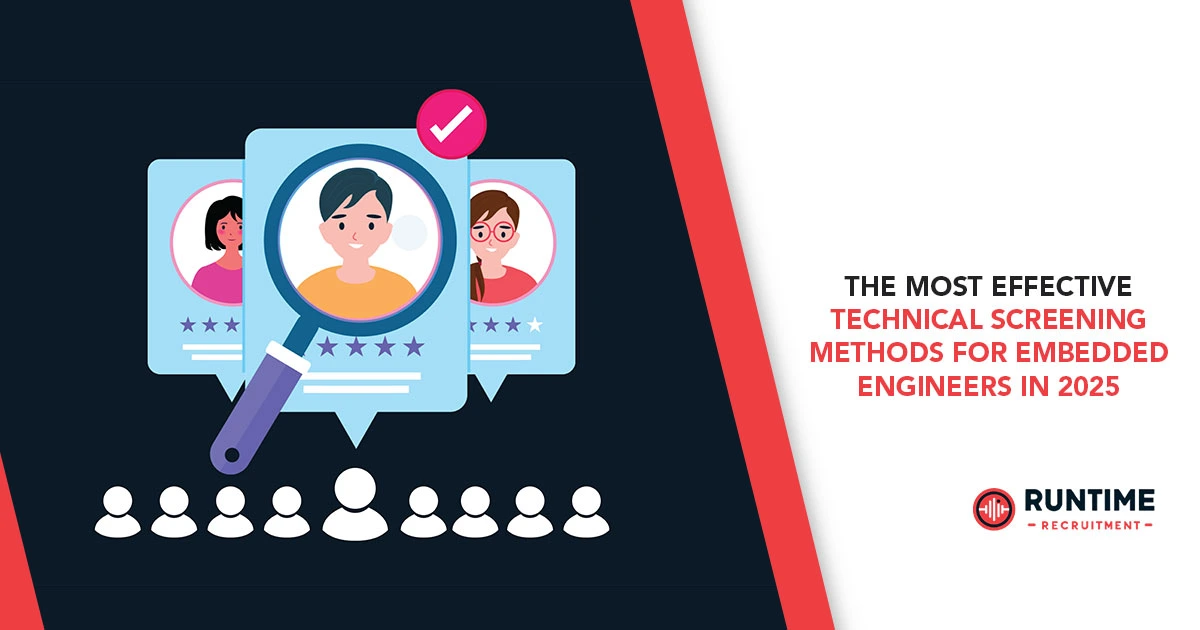The demand for skilled embedded engineers continues to surge, driven by the ever-expanding world of IoT, automotive systems, consumer electronics, and industrial automation. As technology evolves at an unprecedented pace, so too must the methods we use to identify and recruit the best talent in this critical field. Gone are the days when simply reviewing a resume and conducting a generic technical interview sufficed. In 2025, effective technical screening for embedded engineers demands a more nuanced, practical, and forward-thinking approach.
This article delves into the most effective technical screening methods for embedded engineering candidates in 2025, providing actionable insights for hiring managers and recruitment teams looking to secure top-tier talent. We will explore a range of techniques, from advanced resume parsing to real-world coding challenges and behavioral assessments tailored to the specific demands of embedded systems development.
The Evolving Landscape of Embedded Engineering Skills
Before diving into screening methods, it’s crucial to understand the evolving skill set required of embedded engineers in 2025. Beyond fundamental C/C++ programming and microcontroller knowledge, today’s embedded professionals need proficiency in areas such as:
- Real-Time Operating Systems (RTOS): Deep understanding of RTOS concepts, scheduling algorithms, memory management, and inter-process communication is increasingly vital for complex embedded systems.
- Low-Power Design: With the proliferation of battery-powered devices, expertise in minimizing power consumption through hardware and software optimizations is highly sought after.
- Wireless Communication Protocols: Familiarity with protocols like Bluetooth Low Energy (BLE), Wi-Fi, Zigbee, and cellular technologies is essential for connected devices.
- Security in Embedded Systems: As embedded systems become more interconnected, security considerations are paramount. Knowledge of secure coding practices, cryptography, and hardware security modules is becoming a must-have.
- Hardware-Software Co-design: The ability to understand hardware schematics, datasheets, and interact effectively with hardware engineers is crucial for seamless system integration.
- Debugging and Testing: Advanced debugging skills using tools like JTAG debuggers, logic analyzers, and oscilloscopes, along with experience in unit, integration, and system-level testing, are critical for ensuring robust and reliable embedded systems.
- Version Control and Collaboration Tools: Proficiency in Git and collaborative development workflows is essential for modern embedded development teams.
- Scripting Languages: Familiarity with scripting languages like Python for automation, testing, and data analysis can significantly enhance an engineer’s productivity.
- Emerging Technologies: Awareness of and experience with newer technologies like TinyML, RISC-V architecture, and advanced sensor technologies can be a significant advantage.
Why Traditional Screening Methods Fall Short
Traditional technical screening methods often rely heavily on resume reviews and basic algorithmic coding challenges. While these methods can provide a superficial understanding of a candidate’s background, they often fail to accurately assess the practical skills and problem-solving abilities required for success in embedded engineering.
- Resume Bias: Resumes can be misleading, highlighting projects that may not accurately reflect the candidate’s individual contributions or depth of understanding. Keyword matching alone is insufficient to gauge true expertise.
- Abstract Coding Challenges: Many online coding platforms focus on data structures and algorithms that, while important, may not directly translate to the challenges faced in embedded development. Candidates who excel in abstract problem-solving may still lack the practical skills to interface with hardware or debug real-time systems.
- Lack of Context: Traditional interviews often lack real-world context. Asking theoretical questions about RTOS scheduling without exploring how a candidate has applied these concepts in a practical scenario provides limited insight.
- Missed Soft Skills: Embedded development is often a collaborative effort. Traditional technical screens may overlook crucial soft skills like communication, teamwork, and problem-solving under pressure, which are essential for successful team integration.
Effective Technical Screening Methods for 2025
To overcome the limitations of traditional methods, hiring teams need to adopt a more comprehensive and practical approach to technical screening. Here are some of the most effective methods for identifying top embedded engineering talent in 2025:
1. Advanced Resume and Portfolio Analysis: Going Beyond Keywords
While resumes are still a starting point, the analysis needs to be more sophisticated. Instead of just looking for keywords, focus on:
- Quantifiable Achievements: Look for bullet points that highlight specific accomplishments with measurable results, such as “Reduced power consumption by 15% through firmware optimization” or “Successfully implemented a BLE communication protocol resulting in a 20% increase in data transfer rate.”
- Project Depth and Relevance: Encourage candidates to provide detailed descriptions of their projects, including the challenges they faced, the technologies they used, and their specific contributions. Pay close attention to projects that align with your company’s domain and technology stack.
- Open-Source Contributions and Personal Projects: Actively seek out candidates who contribute to open-source embedded projects or have significant personal projects that demonstrate their passion and practical skills. Platforms like GitHub can provide valuable insights into a candidate’s coding style and collaborative abilities.
- Tailored Questionnaires: Supplement resume reviews with targeted questionnaires that delve deeper into specific technical areas relevant to the role. For example, for a role requiring RTOS experience, ask questions about their experience with specific RTOS, their understanding of different scheduling policies, and how they have handled synchronization challenges.
2. Practical Coding Challenges Focused on Embedded Systems
Move beyond abstract algorithmic problems and implement coding challenges that closely mimic real-world embedded development scenarios. Consider the following:
- Hardware Interaction: Design challenges that require candidates to interact with simulated or actual hardware. This could involve tasks like reading data from a virtual sensor, controlling a virtual actuator, or implementing a communication protocol between virtual devices. Platforms that offer virtual embedded development environments can be invaluable here.
- RTOS-Based Tasks: Present challenges that require candidates to utilize RTOS primitives like tasks, queues, mutexes, and semaphores to solve concurrency and synchronization problems.
- Low-Level Programming: Include tasks that assess their understanding of memory management, interrupt handling, and peripheral configuration.
- Debugging Exercises: Provide code snippets with intentional bugs and ask candidates to identify and fix them. This evaluates their debugging skills and their understanding of potential pitfalls in embedded software.
- Take-Home Projects: For more senior roles, consider assigning small take-home projects that allow candidates to demonstrate their ability to design, implement, and test a complete embedded system component. Clearly define the scope and expected deliverables.
3. Embedded System Design and Architecture Discussions
Assess a candidate’s understanding of embedded system design principles and architectural considerations through in-depth discussions. Focus on:
- System Decomposition: Present a hypothetical embedded system requirement and ask the candidate to describe how they would break down the system into different modules and components.
- Hardware-Software Trade-offs: Explore their understanding of the trade-offs involved in choosing different hardware and software components based on factors like performance, power consumption, cost, and reliability.
- Interface Design: Discuss their experience in designing interfaces between different hardware and software modules, including communication protocols and data formats.
- Real-World Problem Solving: Present real-world challenges encountered in embedded systems development (e.g., handling sensor noise, optimizing power consumption in a specific scenario) and ask them to describe their approach to solving these problems.
4. Behavioral Assessments Tailored for Embedded Engineers
While technical skills are paramount, behavioral traits are equally important for success in collaborative embedded development teams. Incorporate behavioral assessment techniques that focus on:
- Problem-Solving Approach: Ask candidates to describe how they have tackled complex technical challenges in the past, focusing on their problem-solving process, their ability to break down problems, and their resourcefulness in finding solutions.
- Communication Skills: Evaluate their ability to clearly and concisely explain technical concepts to both technical and non-technical audiences. This is crucial for effective collaboration within multidisciplinary teams.
- Teamwork and Collaboration: Explore their experiences working in teams, their ability to give and receive constructive feedback, and their approach to resolving conflicts.
- Learning Agility: Embedded technology is constantly evolving. Assess their eagerness to learn new technologies and their ability to adapt to changing requirements.
- Attention to Detail and Quality Focus: Embedded systems often require a high degree of precision and reliability. Assess their commitment to writing clean, well-documented, and thoroughly tested code.
5. Leveraging Simulation and Virtualization Tools
In 2025, simulation and virtualization tools will play an increasingly important role in technical screening. These tools allow you to:
- Create Realistic Embedded Environments: Simulate target hardware and peripherals, enabling candidates to interact with a virtual embedded system without requiring physical hardware.
- Standardize the Assessment Process: Ensure that all candidates are evaluated in the same controlled environment, eliminating inconsistencies and biases associated with different hardware setups.
- Automate Evaluation: Some simulation platforms offer automated scoring and feedback mechanisms, streamlining the screening process and providing objective assessments.
- Assess Hardware-Software Integration Skills: Evaluate a candidate’s ability to write software that interacts correctly with virtual hardware components.
6. Collaborative Online Assessment Platforms
Utilize online assessment platforms specifically designed for technical interviews that offer features like:
- Shared Code Editors: Allow interviewers and candidates to collaborate on code in real-time.
- Integrated Debugging Tools: Enable candidates to debug their code within the platform.
- Virtual Whiteboarding: Facilitate discussions about system design and architecture.
- Recording and Playback: Allow for review of interview sessions for evaluation and training purposes.
Implementing an Effective Screening Process
Building an effective technical screening process for embedded engineers in 2025 requires a strategic and well-defined approach:
- Define Clear Skill Requirements: Before starting the screening process, clearly define the specific technical and soft skills required for the role based on the team’s needs and the projects involved.
- Develop a Multi-Stage Screening Process: Implement a multi-stage process that combines different screening methods to provide a comprehensive evaluation of candidates. This could include:
- Advanced resume and portfolio review.
- Targeted technical questionnaires.
- Practical coding challenges (potentially with hardware simulation).
- Technical interviews focusing on design and architecture.
- Behavioral interviews.
- Train Your Interviewers: Ensure that your interviewers are well-trained in conducting effective technical and behavioral interviews. Provide them with clear guidelines and evaluation rubrics.
- Focus on Practical Skills and Problem-Solving: Prioritize screening methods that assess a candidate’s ability to apply their knowledge to solve real-world embedded engineering problems.
- Provide a Positive Candidate Experience: Remember that the screening process is also an opportunity to attract top talent. Ensure a smooth and respectful experience for all candidates.
- Continuously Evaluate and Iterate: Regularly review the effectiveness of your screening methods and make adjustments based on the quality of hires and feedback from both interviewers and candidates.
Conclusion
The technical landscape of embedded engineering is rapidly evolving, and our recruitment strategies must adapt accordingly. By moving beyond traditional methods and embracing more practical, context-driven, and behavioral assessments, companies can significantly improve their ability to identify and hire the most effective embedded engineers in 2025. Investing in robust technical screening processes is crucial for building high-performing embedded development teams that can drive innovation and success in the years to come.
Ready to connect with top-tier embedded engineering talent? At RunTime Recruitment, we specialize in connecting leading companies with exceptional embedded systems professionals. Contact us today to learn how we can help you build your dream team for 2025 and beyond.
Let’s navigate the future of embedded together.









